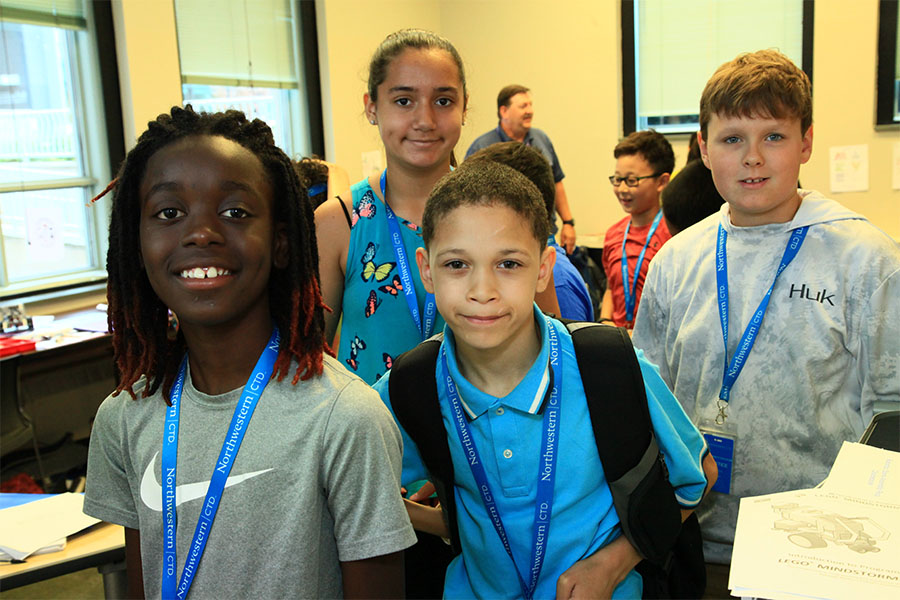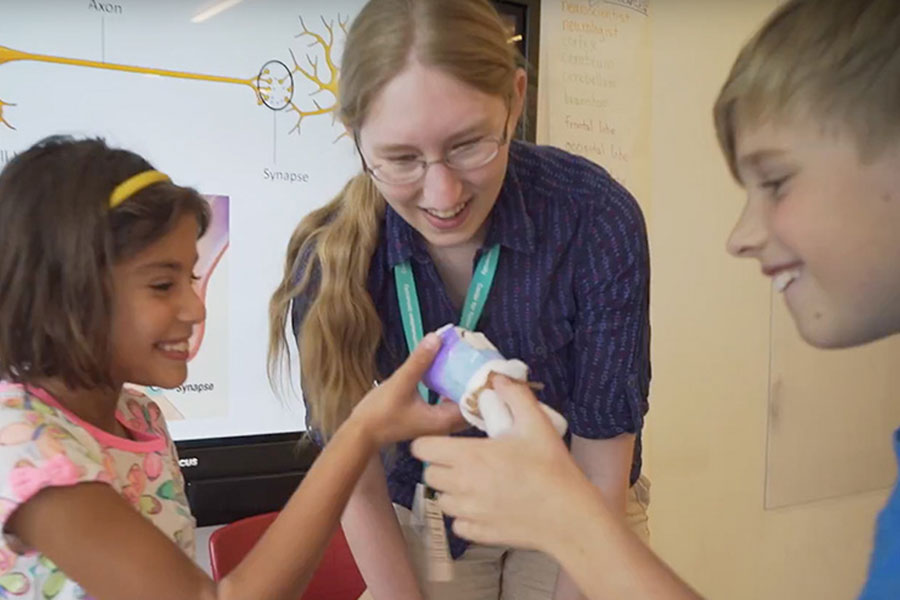Boosting Equitable Gifted Education Efforts—And Agency—through Collaboration
By Ed Finkel
How can strong collaborations between schools and outside-of-school organizations help students develop their talents in an effective, equitable way?
A prime example of collaboration has unfolded in District U-46 in northwest suburban Elgin, Illinois, which has partnered with CTD over the last several years to extend enrichment programming to try to thread this particular needle, partly based on CTD research into what’s necessary to make it happen.
The 40,000-student, racially and ethnically diverse district has developed a comprehensive talent development program starting in the early grades drawing from both its own internal work and that of the collaborations. Among the end results, as chronicled in an article in the Hechinger Report, between 2009 and 2017-18, Hispanic students increased from 46% to 54% of the student body and rose much more quickly—from 26% to 48%--of the gifted population.
 What happened in the meantime? A lawsuit and resulting consent decree provided the initial push, but crucial to the transformation has been the leadership of district gifted coordinator April Wells, a U-46 graduate who is Black and whose giftedness was overlooked until a then-district administrator—a friend’s mother, also Black—encouraged her to advocate for herself.
What happened in the meantime? A lawsuit and resulting consent decree provided the initial push, but crucial to the transformation has been the leadership of district gifted coordinator April Wells, a U-46 graduate who is Black and whose giftedness was overlooked until a then-district administrator—a friend’s mother, also Black—encouraged her to advocate for herself.
Wells has paid it forward to the diverse generation of current students. The district’s talent development program that has been constructed during the past decade focuses on Title 1 elementary schools, which comprise 26 of U-46’s 40 schools, mainly at the second and third grades, although first-grade students have been added at some sites. The district’s program flips the script on how giftedness is typically identified, Wells says.
Traditionally, “we identify before we support learners,” she says. “Our goal is to provide more equitable access for students in households that don’t typically participate in gifted programs. We moved to a model where we provide support first, then make determinations.”
Or as CTD’s research on programming for talent development has framed it:
“Moving from the emergent talent to competency stages, acceleration begins to play more of a role in talent development, although students still need the opportunity to delve deeply into subjects and continue to explore related topics. For elementary and middle school children, programming that focuses on developing content knowledge and technique through all forms of acceleration is necessary. .... At the same time, additional enrichment to broaden and deepen students’ understanding of a subject or domain is needed.”
In U-46, teacher lesson plans place a heavy emphasis on the baselines of inquiry—how to frame questions on different topics and tie them to assets students bring, Wells says. “Our goal is to help develop a ‘scholar’ disposition, so students see themselves as capable and able to engage cognitively and culturally,” she says. “We’re no longer overwhelming [students] with things they don’t know around content; we’re starting with the basis of what they can do and then moving to levels of depth and complexity.”
While the Elgin-based district has maintained partnerships with organizations like Mathletes and the Science Olympiad, those organizations typically focus on learners already identified as gifted, Wells says. “When we think about our work in finding ways to highlight talent in households who are typically left behind, CTD has been my most robust partner,” she says. “Many of our families don’t leave the Elgin area to access resources. How do we make this work when our families don’t realize this is out there? How do we reduce barriers?”
When Wells asked CTD Director Dr. Paula Olszewski-Kubilius those questions a decade ago, “Paula said, ‘Why don’t we bring it to you?’” she recalls. The partnership started on weekends in the spring of 2013 with third graders, focused on specific content areas, with guest appearances by industry leaders. “That helped us raise the ceiling on what they’re able to do, how we enter into different levels of conversations, what more we can do for them,” Wells adds. “The idea that you can have access to enriched activities while still developing the basics, that widened our cognitive palette.”
From there, U-46 changed the structure of its summer school programming away from a remediation focus. Starting in 2016, the district brought in CTD to provide programming for students already identified as gifted as well as those “in the pipeline,” Wells says. In addition to those pieces, the district started partnering with CTD around parent workshops such as the “Opportunities for the Future” conference.
“We take parents to Evanston for those offerings,” she says. “They’re getting access to information and knowledge that they may not have [otherwise] and engage in environments where other families have the same desires, wishes and aspirations. Socioeconomics can sometimes be the barrier and the blockage.”
At the middle-school level, some of U-46’s learners are now accessing Algebra 1 through CTD before it’s offered at the district, and as of this fall, the district has borrowed pieces of summer programming to embed them into STEM classes, Wells says. “We’ve asked teachers to use some of those designs and lesson plans, to connect them,” she says, adding that it’s been a voluntary effort to create a systematic and continuous program by asking, “How can we carry this [programming] over and maximize their pursuits by bringing this into their school day?” she says.
Going forward, Wells would like to leverage course units developed at CTD to build a gifted math and science lane of programming into which the elementary school students whose talents are being developed through weekend and summer programming will naturally flow. She’s working with the superintendent of teaching and learning to bring this about, as U-46 moves to a grade six through eight middle-school model in the 2024-25 school year.
In addition to the significant diversification of the gifted programming, the end results to date of the partnerships with CTD and the district’s overall approach have ranged from across-the-board increases in math achievement scores, to parents regularly querying Wells about when the next student or parent opportunity will be in the offing.
“One of the greatest ways to attest to [the impact] is that we have families who might always have depended on district scholarships and funds, and they’re putting together their own resources and finding ways to pay for [CTD programming],” she says. “They have a willingness to participate in a program where the district is not partnering with CTD.”
Students are also gaining confidence. “One fifth grader said, ‘I never considered applying to Northwestern University. Now I think I can,’” Wells says. “It’s allowing them to see what their giftedness looks like in our local context. Having that name recognition—the Northwestern University Center for Talent Development—has helped our families see that. For families to then start to say, ‘There is something unique about how my child learns, how they demonstrate ability—this is what giftedness looks like.’”
CTD’s research has found this tendency more broadly:
“Beyond what outside-of-school programs do for the participants, there is research to suggest that the programs can also raise parents’ expectations about their child’s achievement, encouraging them to advocate for more challenging coursework in school.”
Wells also recently received a call from a parent of a sixth grader who hadn’t yet reached the district’s benchmark standard for taking Algebra but had reached a couple of others and wanted to know how to get his daughter into a certain science course. “He was telling me about the honors biology course his daughter did over the summer,” she says.
“It’s all gaining a notable sense of traction,” Wells adds. “I’m no longer distributing opportunity; they [parents and families] have a sense of agency. … I’m a cultural broker. That’s the greatest testimony for me, to say, ‘They’re empowered.’ This did arise from [the fact that] maybe they weren’t fully aware of the caliber of their children’s learning. For someone to see them and acknowledge that, and put a system in place to support them, has empowered them to have the agency, and they’re running with it.”

